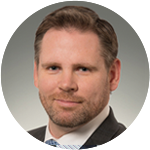Why hope is not an investment strategy
Managing emotions during market volatility

Based on the April 14, 2020 Investments Unplugged podcast, featuring Philip Petursson, Manulife Investment Management Canada’s Chief Investment Strategist, and Apollo Lupescu, Vice President at Dimensional Fund Advisors (DFA). Dimensional Fund Advisors is a leading global investment firm that has been translating academic research into practical investment solutions since 1981. They are a Manulife Investment Management partner and a sub-advisor to Manulife ETFs offered in Canada.
Ongoing market volatility continues to test everyone’s mettle, with oil futures now the latest sector receiving attention-grabbing headlines. In a recent conversation with Manulife Investment Management Chief Investment Strategist, Philip Petursson, Apollo Lupescu of Dimensional Fund Advisors offers his views on investment fundamentals, with a dash of historical reflection on previous market shocks.
With a doctorate in economics from the University of California, Santa Barbara, Lupescu is no stranger to offering highly technical financial insight, but says he prefers using a more personal approach that leans towards empathy.
“None of us are experts in everything, and I don’t think we should assume that the people skilled in different professions are experts at our jargon,” says Lupescu.“ Today it’s more important than ever for advisors and investment managers to start with empathy first because emotions are driving so much of the decisions that investors make. People want to be heard, they want to be understood, and they want somebody who validates their feelings.”
While many investors may feel like they’re on a roller coaster right now, Lupescu urges caution on following instincts that could lead them astray.
“When the market drops, you feel a sense of fear and maybe decide to sell. When the market is going up and up, you’re feeling better and thinking that you should buy. But this roller coaster of emotion is the exact opposite to what a successful investor should do,” says Lupescu.
Rather than letting emotions dictate decisions, investors should be seeking out professional help.
“Successful investors buy low and sell high, but emotions tend to drive investors to do exactly the opposite. It can be very hard for investors today to make sense of it all. This is where an advisor can show their value,” says Lupescu.
Back to the roller coaster analogy — Lupescu says staying in your seat might feel scary but jumping out halfway through the ride can cause you to get hurt.
“Back in my earlier days I would go in and out of the market, particularly when I got a little bit afraid,” says Lupescu. “I thought that selling and moving to cash would somehow alleviate the stress. The problem was that, soon enough, the stress of being invested in the market was very quickly replaced by the stress of being out of the market. You wonder when do you get back in? To me that was more stressful.”
When it comes to investing during times of volatility, referring to your personal plan is the first step.
“Create a financial plan and come up with some financial objectives. And once you have that, then it could be reasonable for you to invest in stocks or reasonable for you to invest in bonds. Once you have that in place, you are well on your way,” says Lupescu.
Political impact
With a US presidential election set for November 2020, it’s interesting to see if that has the potential for affecting the stock market and investor behavior. Curious to find out, Lupescu reviewed 23 different election years, and saw that the US market returned, on average, anywhere from 9 to 10 per cent growth per year.
However, on closer inspection, Lupescu discovered that the market did go down in four of those 23 election years.
“The first one in the data shows up in 1932. The market went down about 8 per cent, it was an election year in the US, and there was also the Great Depression. The next time it happened was 1940. Once again, we had an election, but it was also a time when Europe was being invaded and it was pretty obvious we were heading into a world war. It took 60 years for the next one in 2000. And if you remember, 2000 was the dot-com crash. It was an election year but there was also a big dot-com bust. And the last one was in 2008, which was the great financial crisis. In other words, when you look at the four election years when the market went down, there are much bigger things happening in the world, rather than the election itself,” says Lupescu.
Beyond an election year, does it matter whether a Republican or Democrat sits in the White House? Lupescu’s research finds that historically there’s no evidence when you look at the average return per year.
“The fundamental value of a company comes from profits, and the profits are much more related to their own products, to their own strategy, how they execute it, what their competitors do. When it comes to the market, there are more things at play than who sits in the White House,” says Lupescu.
The way forward….
As this ongoing pandemic continues to disrupt everything that’s familiar, Lupescu urges a positive outlook, reflecting on how previous unprecedented great events prompted a drive toward new opportunity and stronger markets.
“In 1973, we have the OPEC oil embargo, and it was a shock to the system because suddenly oil wasn’t flowing. We [the US] were dependent on foreign oil, and people are lining up for miles to get gas. Headlines described that situation as unprecedented and the economy was doomed because of our dependence on these foreign countries for oil. Fast forward 40 years and the US has become the largest producer of oil, and we changed from the gas-guzzling cars to something much more fuel efficient.”
The market turmoil created by the COVID-19 pandemic draws similar comparisons to the volatility created by World War II.
“As an investor at the end of 1940, with the last four years of the market down, there’s global carnage, with millions of people dying and cities destroyed. Forget about consumers, forget about supply chains, and you’re sitting there wondering what should I do now? I can’t even imagine how difficult a decision it was to invest or not invest. A lot more so than today. And yet what was remarkable was that 1941 to 1945, the S&P 500 returned, on average, over 17 per cent per year during the darkest days of our parents’ generation. And it was remarkable — 17 per cent — way above the historical norm.”
Innovation and opportunity are the reasons why.
“As long as we have free markets, firms will try to find the opportunity and investors will receive the returns. Companies will figure out ways to find the opportunities,” says Lupescu. “We are seeing distilleries shifting from spirits to hand sanitizer; car makers are adjusting production to ventilators. It gives me optimism.”
Important disclosure
Important disclosure
A rise in interest rates typically causes bond prices to fall. The longer the average maturity of the bonds held by a fund, the more sensitive a fund is likely to be to interest-rate changes. The yield earned by a fund will vary with changes in interest rates.
Currency risk is the risk that fluctuations in exchange rates may adversely affect the value of a fund’s investments.
This commentary reflects the views of the sub-advisor of Manulife Investment Management. These views are subject to change as market and other conditions warrant.
The opinions expressed are those of Manulife Investment Management as of the date of this publication, and are subject to change based on market and other conditions. The information and/or analysis contained in this material have been compiled or arrived at from sources believed to be reliable but Manulife Investment Management does not make any representation as to their accuracy, correctness, usefulness or completeness and does not accept liability for any loss arising from the use hereof or the information and/or analysis contained herein. Manulife Investment Management disclaims any responsibility to update such information. Neither Manulife Investment Management or its affiliates, nor any of their directors, officers or employees shall assume any liability or responsibility for any direct or indirect loss or damage or any other consequence of any person acting or not acting in reliance on the information contained herein.
All overviews and commentary are intended to be general in nature and for current interest. While helpful, these overviews are no substitute for professional tax, investment or legal advice. Clients should seek professional advice for their particular situation. Neither Manulife, Manulife Investment Management Limited, Manulife Investment Management, nor any of their affiliates or representatives is providing tax, investment or legal advice. Past performance does not guarantee future results. This material was prepared solely for informational purposes, does not constitute an offer or an invitation by or on behalf of Manulife Investment Management to any person to buy or sell any security and is no indication of trading intent in any fund or account managed by Manulife Investment Management. No investment strategy or risk management technique can guarantee returns or eliminate risk in any market environment. Unless otherwise specified, all data is sourced from Manulife Investment Management.
Manulife, Manulife Investment Management, the Stylized M Design, and Manulife Investment Management & Stylized M Design are trademarks of The Manufacturers Life Insurance Company and are used by it, and by its affiliates under license.

